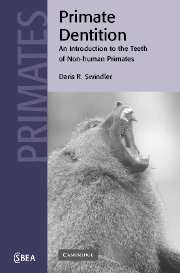7 - Cercopithecidae
Published online by Cambridge University Press: 05 October 2009
Summary
Present distribution and habitat
The family Cercopithecidae is divided into two subfamilies, the Cercopithecinae and Colobinae, which are distributed throughout Asia and Africa between latitudes 35°N and 30°S. The single exception to this is the Japanese macaque (Macaca fuscata), which lives as far north as 41° on the island of Honshu. The cercopithecines have cheek pouches, non-sacculated stomachs, and are essentially non-leaf-eating, whereas the colobines do not have cheek pouches, their stomachs are sacculated, and they are leaf-eating. The cercopithecines have a wider geographic distribution than the colobines, ranging from North Africa in the west to Japan in the east; moreover, the cercopithecines are both terrestrial and arboreal whereas the colobines are predominately arboreal. There is one genus of Colobinae in Africa; all the other members of the subfamily live in India, China, Malaysia and parts of Indonesia.
Members of both subfamilies range from sea level to the snow line. In fact, some langurs live in excess of 3400m in the Himalayas and one species of guenon, Cercopithecus mitis, is found at 3300m in Africa (Rowe, 1996). The predominant mode of locomotion of all Old World monkeys is quadrupedal, whether on the ground or in the trees. Both subfamilies are diurnal.
Dietary habits
Old World monkeys are, for the most part, vegetarians: they eat mostly fruit, leaves, bark, grass, nuts, seeds, and flowers.
Information
- Type
- Chapter
- Information
- Primate DentitionAn Introduction to the Teeth of Non-human Primates, pp. 123 - 146Publisher: Cambridge University PressPrint publication year: 2002
Accessibility standard: Unknown
Why this information is here
This section outlines the accessibility features of this content - including support for screen readers, full keyboard navigation and high-contrast display options. This may not be relevant for you.Accessibility Information
- 1
- Cited by
